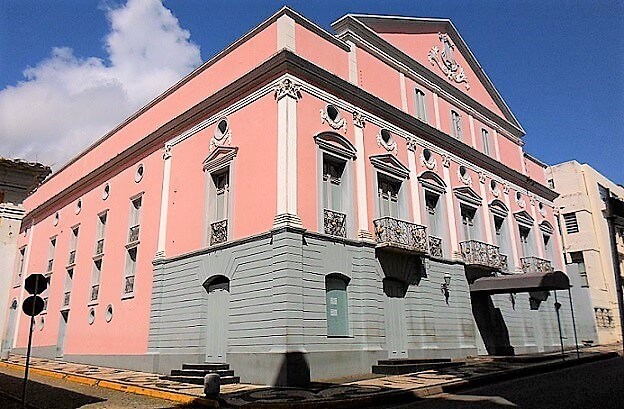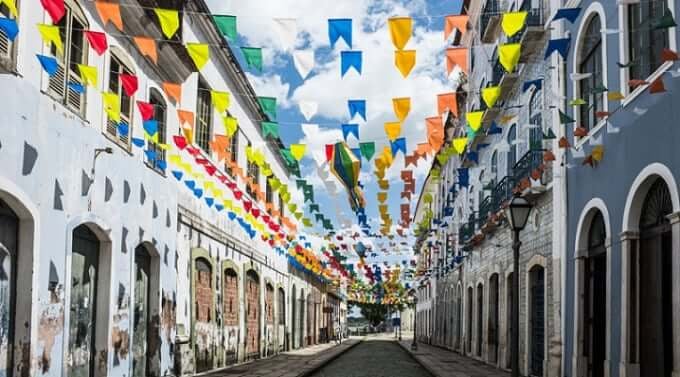Name: Teatro Arthur Azevedo
Address: Rua do Sol 180, Sao Luis, State of Maranhão 65020-590
Official/Related Site URL: http://www.cultura.ma.gov.br/taa/

5 recommended tourist spots in the UNESCO World Heritage “Tile Town” of São Luís
São Luís is the capital of Maranhão state in Brazil. It is located in the delta formed by the Mearim, Itapecuru, and Pindaré rivers, with a population of around 1 million. São Luís is the only city in Brazil built by the French. The town's name is said to have been given in honor of French King Louis XIII and Saint Louis IX.
The city prospered through the production and export of sugarcane and cotton, and during Portuguese rule, many luxurious mansions were built adorned with beautiful tiles. The town, with its tiled walls in the old district, is known as the "Tile Town." In 1997, the historic area of São Luís, including its streets and churches, was designated as a UNESCO World Heritage site. Let's explore the town of São Luís.
table of contents
[x] close
5 recommended tourist spots in the UNESCO World Heritage “Tile Town” of São Luís
1. Teatro Arthur Azevedo

One of the most famous theaters in São Luís, Teatro Arthur Azevedo was built in the early 19th century. It is the fourth theater built in São Luís. With a capacity to accommodate 800 spectators and an exceptional level of comfort, it quickly became the most popular theater in São Luís, surpassing others in quality. In the 1920s, Teatro Arthur Azevedo was honored and began to be referred to as São Luís Theater.
Today, various performances are still held there, making it a thriving entertainment spot for locals. If you’re visiting São Luís, Teatro Arthur Azevedo is a must-see.
2. Palácio dos Leões
A symbol of Maranhão’s culture, Palácio dos Leões is located in the historic center of São Luís. The palace, built in the early 16th century, was renamed "Saint Louis" by the French commander who invaded the area. After the French were expelled, the fort in São Luís was renamed "São Felipe" by the Portuguese. The palace was damaged during national reforms and invasions but underwent a complete renovation of its façade and interior from the 1990s to the early 2000s.
Palácio dos Leões is made of stone and lime and is situated on a riverfront, offering a beautiful view of the sea. On sunny days, the palace’s beauty stands out even more. It's recommended to visit on a clear day to fully appreciate its charm.
Name: Palácio dos Leões
Address: Avenida Pedro II s/n, São Luís, State of Maranhão 65010-910
Official/Related Site URL: https://passeiourbano.com/2011/12/02/palacio-dos-leoes/
3. San Luis Historic District

The São Luís Historic District was designated a UNESCO World Heritage site in 1997. Known for its unique architectural techniques and urban structure, the district was originally the site of the indigenous Tupinambá people’s settlement. Over the years, it has been shaped by invasions from the Portuguese, French, and Dutch, as well as its time as an independent state. The mixture of these diverse cultures has created a one-of-a-kind landscape.
Within the historic district, you’ll find many attractions, including grain houses, Palácio dos Leões, the cathedral, monasteries, Casa das Minas, and Teatro Arthur Azevedo. The 19th-century tile buildings that represent São Luís’s history are also a highlight. Be sure to take a stroll through the São Luís Historic District.
Name: Centro Histórico de São Luís
Address: São Luís, State of Maranhão
Official/Related Site URL: http://portal.iphan.gov.br/pagina/detalhes/34
4. Maranhão Historical Museum
The Maranhão Historical Museum, established in 1973, is a recommended tourist destination that combines the history of Maranhão state with an art space. The exhibits include porcelain, coin collections, crystals, paintings, sculptures, engravings, Catholic religious art, African-origin art, documentary collections, and 19th-century tiles, among others.
In addition to the exhibits, the museum also hosts film screenings and cultural performance exhibitions, offering a space for contemporary art enjoyment. Theater performances are occasionally held in the attached theater, making the Maranhão Historical Museum a place where you can experience art from both the past and present. It’s a museum where you can immerse yourself in the history of São Luís while enjoying art, so be sure to visit during your trip.
Name: Museu Histórico e Artístico do Maranhão
Address: Rua do Sol 302, São Luís, State of Maranhão 65020-590, Brazil
Official/Related Site URL: http://www.cultura.ma.gov.br/portal/mham/
5. Convento das Mercês
The Convento das Mercês monastery was originally built in the 15th century using straw and mud, but later, it was reconstructed by the citizens of São Luís using stone and lime. During Brazil's independence, the government repurposed the monastery for use as a fire station and to house the national police. Over time, the monastery underwent expansions and renovations, and today it serves as a historical center.
The Convento das Mercês is a key part of São Luís’s historical heritage, and it’s definitely worth visiting while touring the city.
Name: Convento Das Mercês
Address: Rua Da Palma, 502, Desterro | Desterro, São Luís, State of Maranhão, Brazil
Official/Related Site URL: https://pt.wikipedia.org/wiki/Convento_das_Mercês
◎ Summary
São Luís, the only city in Brazil built by the French, has many attractions, but the historic district, known as the "Tile Town," is a must-see. The area is home to numerous historical buildings like the cathedral and monasteries, making it perfect for sightseeing. It’s no surprise that São Luís’s historic district is listed as a UNESCO World Heritage site. The unique architectural techniques, utilizing the river mouth and sea breeze, have created a stunning cityscape. Experience Brazil’s culture in the historic district by the sea.
RELATED ARTICLES
REGIONS
CATEGORIES
FEATURED ON Guide
-

Where will you go for the summer vacation? Introducing recommended spots for domestic travel
-

Kaizu City’s Recommended 7 Tourist Spots. Enjoy the Culture and History Nurtured by Wajū!
-

What Makes Ashikaga Flower Park So Special? A Treasure Trove of Photo-Worthy Spots!
-

600 Years of Radiant Tradition: Korea’s Historic Villages of Hahoe and Yangdong
-

Two-Colored Seas and a Pink Beach! 4 Must-Visit Spots in North Eleuthera
MOST POPULAR ON Guide
-
 1
1Doha: Must-see Attractions in the Capital of Qatar
-
 2
2Toronto: 10 Things to do in this Picturesque Canadian City
-
 3
3Amarillo: A City Famous for It’s Amazing Canyons, Great History and Music
-
 4
4South Korea: Dazzling Scenery, Rich Culture and Fascinating History
-
 5
5Kuwait: A Country in Middle East Asia Famous for Hot Sand Dunes and Stunning Cityscape





